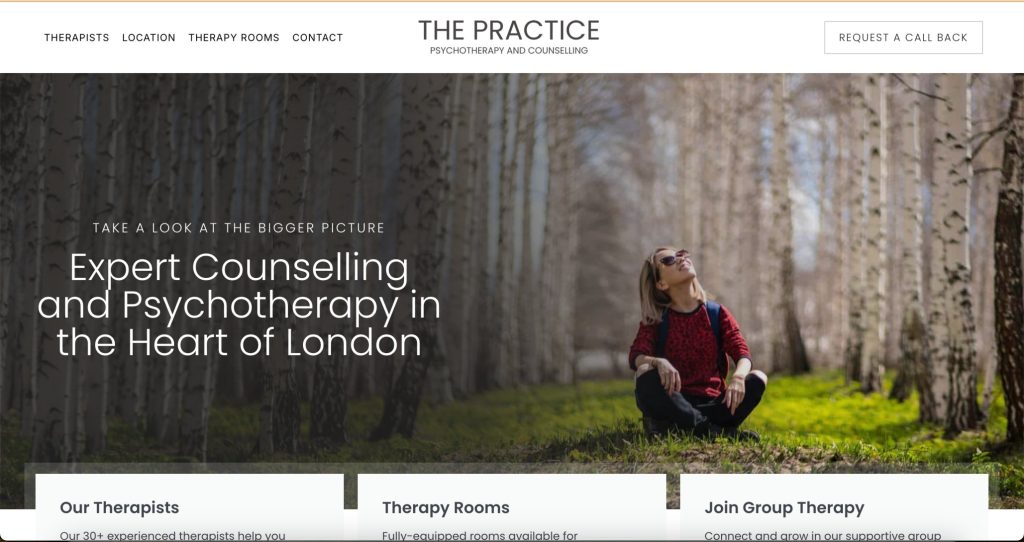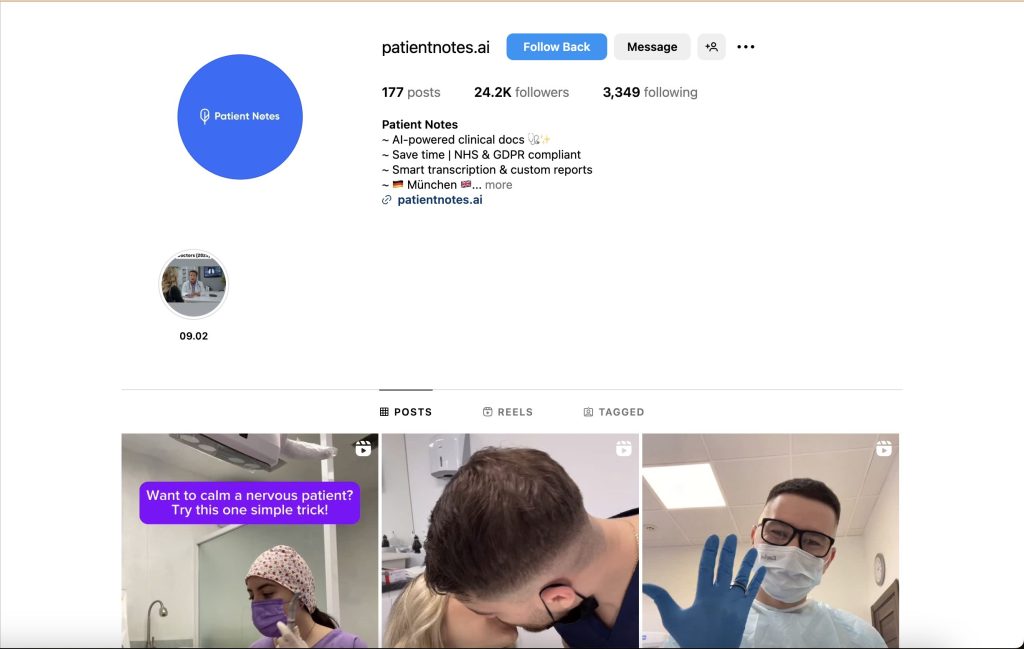In today’s digital-first healthcare landscape, therapy practices must establish a compelling online presence to connect with clients seeking mental health support. As we move through 2025, implementing effective digital marketing strategies has become fundamental for therapists looking to grow their practice and reach those in need of their services.
This comprehensive guide explores 7 powerful digital marketing approaches specifically designed for mental health professionals. Whether you’re a solo practitioner or managing a group practice, these strategies will help you expand your digital footprint, attract ideal clients, and build a flourishing therapy business.
Building a Professional Online Presence
Your digital presence serves as the first touchpoint for prospective clients. Creating a compelling online identity involves several critical components:
Creating an Effective Therapy Website
Your website functions as your practice’s digital headquarters—a place where potential clients form their initial impressions and decide whether to book a session. A high-quality therapy website should include:
- Professional design: Create a visually appealing interface that communicates professionalism while maintaining a warm, approachable feel. Select colours, fonts and imagery that align with your therapeutic approach and make visitors feel comfortable.
- Intuitive navigation: Implement straightforward site structure with clear menu options, allowing visitors to find information quickly. A frustrating website experience may discourage potential clients from reaching out.
- Mobile responsiveness: With over 60% of healthcare searches occurring on mobile devices, your website must function perfectly across all screen sizes.
- Fast loading times: Website speed directly impacts user experience and search rankings. Optimise images, utilise browser caching, and select a reliable hosting provider to ensure quick loading times.
- Clear service descriptions: Clearly articulate your therapeutic specialties, approaches, and client populations. Help visitors understand exactly how you can support their mental health journey.
- Streamlined booking process: Implement an intuitive online booking system that makes it easy for prospects to schedule consultations. Each additional step in this process reduces conversion rates.

Your website should ultimately convey your therapeutic philosophy while making it straightforward for visitors to take the next step toward becoming clients.
Implementing Effective SEO Strategies
Search engine optimisation (SEO) makes your practice discoverable when potential clients search for therapy services. Here’s how to strengthen your therapy practice’s SEO:
- Keyword research: Identify relevant search terms potential clients use when looking for therapy services in your area. Tools like SEMrush or Ahrefs can help uncover valuable keywords specific to mental health services.
- Location-based optimisation: Incorporate location-specific keywords throughout your site (e.g., “anxiety therapist in Brighton” or “marriage counselling in Manchester”).
- Content optimisation: Create dedicated service pages for each therapy specialty, optimising headings, meta descriptions, and content for relevant keywords.
- Technical SEO: Ensure your website has proper schema markup, fast loading times, and a secure connection (HTTPS) to meet Google’s technical requirements.
- Quality backlinks: Develop relationships with reputable websites in the mental health field to earn valuable backlinks, which signal your site’s authority to search engines.
Consistent application of these SEO techniques gradually improves your visibility in search results, driving more qualified traffic to your therapy practice website.
Mastering Local SEO for Therapists
Local SEO is particularly important for therapy practices since most clients prefer working with therapists in their geographic area. To optimise your local presence:
- Google Business Profile: Create and fully optimise your Google Business Profile with accurate contact information, business hours, photos, and service details. Encourage satisfied clients to leave positive reviews.
- Local directories: Ensure your practice is listed in relevant local directories and healthcare platforms with consistent name, address, and phone number (NAP) information.
- Local content: Develop content specifically addressing mental health topics relevant to your local community.
- Local keywords: Include location-specific terms in your page titles, headers, meta descriptions, and content.
- Location pages: For practices with multiple locations, create dedicated pages for each office with unique, location-specific content.
Effective local SEO helps your practice appear in the crucial “Map Pack” results that display at the top of local search queries, significantly increasing your visibility to nearby clients.
Strategic Social Media Marketing
Social media platforms offer therapists powerful channels to build community, demonstrate expertise, and connect with potential clients. Here’s how to leverage social media effectively:
Selecting the Right Platforms
Not all social media platforms will yield results for your therapy practice. Focus your efforts on platforms where your ideal clients spend time:
- Instagram: Excellent for visual content and reaching younger demographics. Perfect for sharing mental health infographics, wellness tips, and practice updates.
- Facebook: Offers robust community-building features and demographic targeting options. Ideal for sharing longer-form content and hosting therapy-related groups.
- LinkedIn: Valuable for connecting with referral sources, other healthcare professionals, and corporate clients for employee assistance programmes.
- Twitter/X: Useful for joining mental health conversations and sharing brief insights on current topics.
- Pinterest: Effective for visual content with long lifespans that can drive traffic to your website over time.

Rather than stretching yourself across all platforms, select 2-3 that align with your practice goals and client demographics.
Creating Engaging Mental Health Content
Developing content that resonates with your audience requires balancing educational value with engagement. Effective content strategies include:
- Educational posts: Share practical mental health tips, explanations of therapy approaches, and insights into psychological concepts.
- Destigmatising mental health: Create content that normalises seeking help and discusses mental health topics openly and compassionately.
- Behind-the-scenes glimpses: Show the human side of your practice with photos of your office space or introductions to your team (while maintaining client confidentiality).
- Client questions: Address common questions and concerns people have about starting therapy.
- Timely content: Connect mental health topics to seasonal themes, awareness months, or current events when appropriate.
Remember to maintain professional boundaries and avoid offering direct therapeutic advice through social media.
Leveraging Paid Social Advertising
Organic reach on social platforms continues to decline, making paid advertising increasingly important. Effective social media advertising for therapists includes:
- Targeted audience selection: Define specific demographics, interests, and behaviours to reach potential clients most likely to need your services.
- Compelling ad creative: Develop visually appealing ads with clear, compassionate messaging that speaks to client pain points.
- Strategic offers: Consider promoting a free resource, webinar, or initial consultation to encourage engagement.
- Retargeting campaigns: Implement pixel tracking to reconnect with website visitors who didn’t immediately book a session.
- Ad performance analysis: Regularly review metrics to optimise campaigns and improve return on investment.
Even with modest budgets, strategic social media advertising can significantly expand your practice’s visibility and client acquisition.
Email Marketing & Client Relationships
Email marketing remains one of the most effective digital channels for nurturing relationships with current and prospective clients. When implemented thoughtfully, email campaigns build trust and encourage ongoing engagement.
Building a Compliant Therapy Practice Email List
Growing your email list must be done with careful attention to healthcare privacy regulations:
- Opt-in mechanisms: Place email sign-up forms strategically on your website, offering valuable mental health resources in exchange for contact information.
- Clear consent: Ensure subscribers explicitly agree to receive communications from your practice.
- Privacy policies: Clearly explain how you’ll use subscriber information and maintain confidentiality.
- GDPR and HIPAA compliance: Follow relevant data protection regulations in all email marketing activities.
Focus on growing a quality list of engaged subscribers rather than simply maximising list size.
Creating Valuable Email Campaigns
Once you’ve established a subscriber base, develop email content that provides genuine value:
- Welcome sequences: Create an automated series introducing new subscribers to your practice, therapeutic approach, and available resources.
- Mental health newsletters: Share regular updates with practical tips, research insights, and practice news.
- Educational series: Develop multi-part email courses addressing specific mental health topics relevant to your client base.
- Client retention emails: Send check-in messages to past clients, reminding them of your availability for future support.
- Event announcements: Promote workshops, webinars, or group therapy opportunities to your subscriber base.

The most effective email campaigns build relationships through consistent, valuable communication rather than frequent promotional messages.
Effective Online Advertising
Strategic paid advertising accelerates practice growth by placing your services in front of actively searching potential clients.
Google Ads for Therapy Practices
Google Ads allow you to appear at the top of search results for specific keywords related to therapy services:
- Strategic keyword selection: Target specific terms potential clients use when seeking therapy (e.g., “anxiety therapy near me” or “trauma therapist London”).
- Negative keywords: Exclude irrelevant searches to preserve your budget for qualified prospects.
- Compelling ad copy: Craft empathetic headlines and descriptions that speak directly to client needs and differentiate your practice.
- Effective landing pages: Direct ad traffic to specific, conversion-optimised pages rather than your homepage.
- Call extensions: Make it simple for prospects to call directly from search results.
- Conversion tracking: Implement proper tracking to measure which ads generate actual appointment bookings.
With thoughtful campaign management, Google Ads typically provide the highest intent traffic for therapy practices.
Display and Remarketing Campaigns
Beyond search ads, display advertising raises awareness and reconnects with website visitors:
- Visual brand building: Develop professional banner ads that communicate your practice values and specialties.
- Placement targeting: Display ads on websites related to mental health, wellness, and self-improvement.
- Remarketing strategies: Show targeted ads to previous website visitors who didn’t book a session, gently reminding them of your services.
- Audience segmentation: Create different ad messaging for various visitor types based on which pages they viewed on your site.
Display advertising complements search campaigns by building familiarity with your practice among potential clients.
Content Marketing Excellence
Thoughtful content marketing establishes your authority in the mental health field while providing genuine value to your audience.
Developing a Therapy Blog Strategy
A therapy blog serves multiple purposes—educating prospective clients, improving SEO, and demonstrating your expertise:
- Strategic topic selection: Create content addressing common client questions, therapy approaches, and mental health conditions you treat.
- SEO-optimised articles: Structure blog posts to rank for relevant keywords, including proper headings, meta descriptions, and internal linking.
- Consistent publishing schedule: Maintain a regular posting cadence to build audience expectations and satisfy search engines’ preference for fresh content.
- Varied content formats: Incorporate case studies (anonymised), expert interviews, research summaries, and practical self-help techniques.
- Promotion plan: Share blog content across your social channels and in email newsletters to maximise readership.
Quality consistently outperforms quantity—focus on creating comprehensive, valuable articles rather than frequent, superficial posts.
Expanding to Video Content
Video content creates personal connections with potential clients before they ever enter your office:
- Practice introduction videos: Create warm, approachable introductions to your therapy team and office environment.
- Therapeutic concept explanations: Develop short videos explaining therapy approaches, mental health concepts, or self-care strategies.
- FAQ sessions: Address common questions about therapy in an accessible video format.
- Testimonial videos: Feature de-identified client success stories (with appropriate permissions and privacy safeguards).
- Live Q&A sessions: Host occasional live streams to engage directly with your audience.
Videos need not be technically perfect—authenticity and helpful content matter more than production quality for therapy practice marketing.
Analytics and Strategy Refinement
Data-informed decision-making separates successful digital marketing from wasted effort and resources.
Tracking Key Performance Indicators
Identify and monitor metrics that genuinely impact practice growth:
- Website analytics: Track visitor behaviour, including traffic sources, popular pages, time on site, and conversion activities.
- Search performance: Monitor keyword rankings, click-through rates, and organic traffic growth.
- Social media metrics: Evaluate engagement rates, follower growth, and traffic generated from social platforms.
- Email statistics: Analyse open rates, click-through rates, and conversion actions from email campaigns.
- Appointment conversions: Track which marketing channels generate actual appointment bookings.
Establish regular reporting schedules to identify trends and inform strategic adjustments.
Adapting to Digital Marketing Changes
The digital landscape evolves constantly, requiring therapy practices to remain flexible:
- Algorithm updates: Stay informed about changes to search and social media algorithms that affect visibility.
- Emerging platforms: Evaluate new digital channels as they emerge for potential fit with your practice marketing.
- Changing client behaviours: Monitor shifts in how potential clients search for and evaluate therapy services.
- Competitive analysis: Regularly assess competitor digital strategies to identify opportunities and threats.
- Budget reallocation: Shift resources toward channels delivering the strongest results for your specific practice.
Successful digital marketing requires ongoing refinement rather than static “set and forget” approaches.
Working with Digital Marketing Professionals
While many therapists manage aspects of their digital marketing independently, professional support often accelerates results.
When to Consider Professional Help
Signs your practice might benefit from expert marketing assistance include:
- Stagnant practice growth: You’re not seeing consistent increases in new client inquiries despite marketing efforts.
- Limited time: Client care responsibilities leave insufficient time for effective marketing implementation.
- Technical challenges: You find the technical aspects of website management, SEO, or advertising platforms overwhelming.
- Unclear strategy: You’re implementing various digital tactics without a cohesive plan or measurable results.
- Competitive pressures: Other practices in your area have sophisticated digital presences that outperform yours.
Professional marketing support can range from occasional consultation to comprehensive management of your digital presence.
Selecting the Right Marketing Partner
When choosing marketing support for your therapy practice, consider these factors:
- Healthcare specialisation: Look for partners with specific experience marketing therapy and mental health services.
- Privacy compliance: Ensure they understand and adhere to healthcare privacy regulations in all marketing activities.
- Results measurement: Expect clear reporting on meaningful metrics, not just vanity statistics.
- Communication style: Find partners who explain strategies in accessible terms and value your input.
- Growth focus: Choose marketers focused on generating qualified client inquiries, not just improving digital metrics.
The right marketing relationship feels collaborative rather than transactional, with partners who genuinely understand the unique nature of therapy practice marketing.
Frequently Asked Questions
How much should therapists spend on digital marketing?
Effective marketing budgets for therapy practices typically range from 5-10% of target revenue. New practices may need to invest at the higher end of this range, while established practices with strong referral networks might allocate less. Start with a modest budget focused on one or two channels (such as Google Ads and website SEO), measure results, and gradually expand your marketing investment based on performance data.
How can therapists maintain client confidentiality in digital marketing?
Protecting client confidentiality in marketing requires careful attention. Never use actual client stories without explicit written permission, and even then, alter identifying details. Use composite case examples rather than specific client situations. Ensure your website contact forms include privacy disclaimers. When collecting email addresses for marketing, maintain separate systems from clinical communications. Consider having marketing materials reviewed by healthcare legal counsel to verify compliance with privacy regulations.
How long does it take to see results from digital marketing for a therapy practice?
Digital marketing results typically follow different timelines: paid advertising (Google Ads, Facebook Ads) can generate new inquiries within days of campaign launch. Social media typically requires 3-6 months of consistent posting to build meaningful engagement. SEO efforts usually take 4-8 months to significantly impact search rankings and organic traffic. Email marketing effectiveness builds progressively as your list grows. For most practices, a comprehensive digital strategy begins showing measurable client acquisition improvements within 3-4 months, with results continuing to strengthen over time.
Can digital marketing help with specific therapy niches?
Digital marketing is particularly effective for therapy practices with specific niches. Focused specialisation allows for more targeted keyword strategies, more relevant content creation, and more precise audience targeting in advertising. For example, a therapist specialising in perinatal mental health can create content specifically addressing pregnancy and postpartum concerns, target keywords like “postpartum depression therapist,” and direct advertising to new and expecting parents. This targeted approach typically yields higher conversion rates and lower client acquisition costs compared to marketing general therapy services.
What are the most common digital marketing mistakes therapists make?
Common digital marketing mistakes include: focusing exclusively on list-building rather than genuine engagement; creating generic “about us” website content instead of addressing specific client needs; neglecting proper tracking to measure marketing effectiveness; inconsistent posting and campaign management; overspending on platforms that don’t reach your ideal clients; and using overly clinical language that doesn’t resonate with potential clients. The most significant mistake is failing to clearly communicate how your therapy services specifically address the challenges your ideal clients are experiencing.
Digital Marketing Platforms Comparison for Therapists
| Platform | Best For | Typical Cost | Time Investment | Difficulty Level |
|---|---|---|---|---|
| Google Ads | Finding clients actively searching for therapy | £15-25 per click in competitive markets | 2-3 hours/week | High |
| Facebook/Instagram Ads | Building awareness and reaching specific demographics | £1-2 per click | 3-4 hours/week | Medium |
| SEO | Long-term sustainable client acquisition | £300-1000/month (agency) or time investment | 5-10 hours/week if DIY | High |
| Email Marketing | Nurturing relationships with potential clients | £15-50/month (platform) | 2-4 hours/week | Medium |
| Social Media (Organic) | Community building and practice branding | Free (time investment) | 3-5 hours/week | Low-Medium |
| Content Marketing/Blogging | Establishing expertise and improving SEO | Free-£200/post (if outsourced) | 3-6 hours/week | Medium |
Integrating Digital Marketing Strategies
While each marketing channel offers distinct benefits, the most effective therapy practice marketing integrates multiple approaches into a cohesive strategy.
Creating a Coordinated Marketing Plan
Rather than implementing disconnected tactics, develop an integrated approach where each channel supports the others:
- Use blog content to fuel social media posts and email newsletters
- Direct paid advertising traffic to specially designed landing pages
- Repurpose video content across multiple platforms
- Ensure consistent messaging and branding across all digital touchpoints
- Develop clear patient journeys from initial awareness through scheduling
A coordinated strategy maximises each marketing pound spent while creating multiple opportunities to connect with potential clients.
Digital Marketing Checklist for Therapy Practices
Print this checklist to track your therapy practice marketing progress
Balancing Short and Long-Term Marketing
Effective therapy practice marketing balances immediate results with sustainable growth:
Short-term tactics:
- Paid advertising on Google and social platforms
- Limited-time promotional campaigns
- Email outreach to your existing network
- Local partnership opportunities
Long-term investments:
- Website optimisation and SEO
- Content marketing and blogging
- Email list building
- Social media community development
- Professional referral network cultivation
The ideal marketing mix allocates resources to both quick-win strategies and foundation-building efforts that deliver compounding benefits over time.
Key Takeaways
- Digital presence is essential: A professional website optimised for both user experience and search engines forms the foundation of effective therapy practice marketing.
- Local focus matters: Most therapy clients search locally, making local SEO strategies particularly valuable for practice growth.
- Content builds authority: Thoughtful blog posts, videos, and social content establish your expertise while addressing potential clients’ questions and concerns.
- Multi-channel approach works best: Integrate website optimisation, content marketing, social media, email, and paid advertising for maximum impact.
- Measure and refine: Track meaningful metrics across all marketing channels and continuously adjust strategies based on performance data.
- Privacy remains paramount: All digital marketing efforts must maintain absolute commitment to client confidentiality and regulatory compliance.
- Professional support accelerates results: Consider working with marketing specialists who understand the unique challenges of promoting therapy services.
By implementing these digital marketing strategies consistently and thoughtfully, your therapy practice can build meaningful connections with potential clients, differentiate from competitors, and create a sustainable growth trajectory in 2025 and beyond.
Additional Reading Material
- 15 Proven Dental Marketing Strategies to Attract New Patients in 2025
- Attract Physiotherapy Patients Online: 9 Proven Strategies for 2025
- Digital Marketing for Physiotherapists: Complete Guide for Practice Growth
- 9 Best AI Clinical Documentation Tools in 2025: Complete Comparison
- AI in Medical Documentation: Transforming Healthcare Efficiency in 2025



